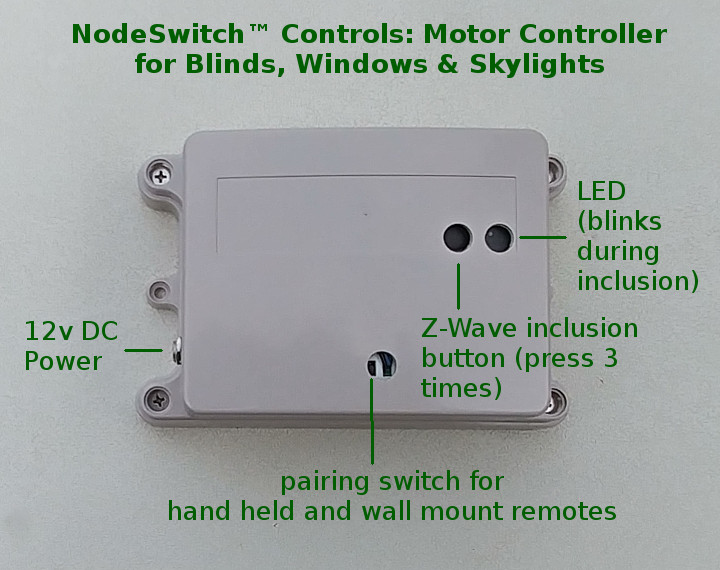Z-Wave Group Controller: Cloning Motors Into the Group
This is part 1 of the instructions for our DCC-ZW-12RNA Z-Wave group controller for blinds, drapes, skylight shades and window/skylight openers. You can use this controller for any of our reversible DC motors, including our CurtainCloser™ and ShadeSlider™ systems.
Our Z-Wave controller can control as many motors as you assign to the group, whether there are 2 or 200 motors in the group (for simultaneous operation). This is accomplished with our group transmitter module triggered by Z-Wave digital radio control signals.

Assigning a Master Channel to Each Motor in the Group
These instructions assume that you have a master remote, and that you have already created a master channel for the motor you want to control. If you have not done this, please see this page and follow the instructions, before you start creating your group:
How to create a master channel assignment for a motor
The instruction link above refers to a 15 ch remote with one of our wireless battery motors, but if you have any of our wired radio equipped motors, the process is the same. When you have created a master channel for a motor (which also allows you to set individual travel limits), you can clone it to the transmitter module we are discussing in this article.
Controlling a Group of Motors: Cloning to the Group Transmitter
Here the instructions for the cloning procedure:
- Make sure the master REMOTE is set to the master channel you want to clone; the next actions must be completed within 6 seconds of each other:
- Press and release the P2 button TWICE on the MASTER REMOTE that holds the master channel you want to clone, the motor will beep once and jog each time. PLEASE NOTE: If you have a multi-channel wall remote, there is no P2 button; just use the combination keypress of UP and STOP instead.
- Press and release the PAIRING button on the z-wave controller once, to complete the pairing.
- At this point, you are finished with the pairing. The internal transmitter module will control the motor, and the travel limits will not be changed. You will still need to follow the Z-Wave inclusion process with your Z-Wave hub (in Part 2), before you can test it.
- Please Note: You can clone up to 20 different remote channels to the Z-Wave unit for multiple controls, but please wait 10 seconds for the programming cycle to complete before you clone another channel.
Here is the 'un-cloning' procedure:
- Follow the exact same instructions as above, the only difference is that the motor will beep 5 times and jog to indicate channel was removed from transmitter.
A Word About Digital Radio Signal Range
We have tested a single installation here with about 60 feet of range with the Zwave hub on one floor and the controller on a second floor, with about 4 rooms in between (typical wood frame/sheetrock home construction).
It is important to understand that the radio signal that is transmitted from the controller to the motor is much more powerful than the Zwave signal - it will reach anywhere in a typical home, so it's ok to put the controller close to the Zwave hub and let the direct motor control signal do the heavy lifting.
Also, keep in mind that most Zwave devices are also 'signal forwarders' (including the unit in our controller) so adding more devices in your home should improve the Zwave range results.
If you are dealing with a concrete or cinder block structure, please note that your radio signals will not have as much range.
Purchase This Unit in Our Online Store
You can purchase our Z-Wave group controller for blinds and window openers, and our other control products in our online DIY automation store.
Adrian Biffen
Senior Partner
NodeSwitch™ Controls
We sincerely hope you enjoy our advanced technology products; if you have any questions, please contact us at any time!
Z-Wave Controller Article Series
Part 1: Z-Wave Blind Control: Cloning Motor Channels (you are here)

 Shopping Cart Home - Start Here
Shopping Cart Home - Start Here Z-Wave Motor Control
Z-Wave Motor Control Remote Controls for Radio Equipped Motors
Remote Controls for Radio Equipped Motors DIY Starter Kits for Window Shades
DIY Starter Kits for Window Shades DIY Starter Kits for Window Openers
DIY Starter Kits for Window Openers Alexa & Broadlink RM4 Pro Home Theater Control
Alexa & Broadlink RM4 Pro Home Theater Control Zwave Motor Control: Introduction
Zwave Motor Control: Introduction Shelly WiFi Wireless Motor Control
Shelly WiFi Wireless Motor Control Zigbee Motor Control (Under Development)
Zigbee Motor Control (Under Development) Raspberry Pi as a Home Automation Hub
Raspberry Pi as a Home Automation Hub Hubitat Elevation & Broadlink RM Pro Emitter
Hubitat Elevation & Broadlink RM Pro Emitter Blind Motors
Blind Motors Window Openers
Window Openers Skylight Openers
Skylight Openers Shade Slider
Shade Slider Curtain Closer
Curtain Closer Track Glider
Track Glider Background & Mission Statement
Background & Mission Statement Customer DIY Testimonials
Customer DIY Testimonials Contact Page
Contact Page